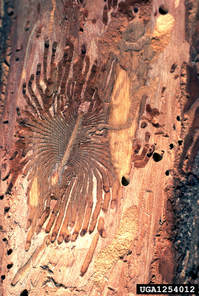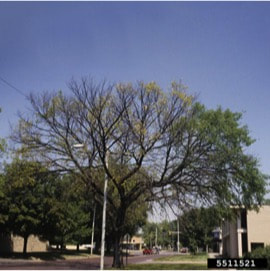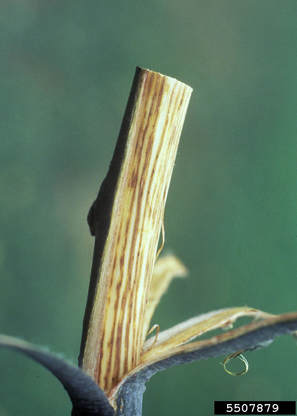web page by Emily Reif, 2018
Photo by: Michelle Grabowski, University of Minnesota Extension
Background
Dutch Elm Disease (DED) is a severe fungal disease that nearly wiped out all of the American elm trees in the 1960s and 1970s and is still killing elm trees (1). American elm trees are well suited to grow in an urban environment, and were widely planted as street trees throughout the United States (2).
origin & life cycle
The fungal agent that causes this disease spread from Europe to the United States prior to the 1930s (2). There are two fungi that cause this disease, Ophiostoma ulmi and Ophiostoma novoulmi (2). The fungi spread from infected trees to health trees via a beetle vector or through grafted roots (1,3). The main beetle vectors are the native elm bark beetle and the European elm bark beetle (figure 2) (2). These beetles are attracted to stressed, dying, and dead elm trees to complete the breeding stage (2). Adult beetles burrow into the wood and lay their eggs in galleries, once the eggs hatch the larvae feed on the sapwood and inner bark (figure 3) (2,3). Dutch Elm Disease results in a fungal infection in the vascular systemof the tree, which causes clogging in the vascular system and prevents water from moving to the crown (2). The main visual symptoms are wilting and dieback (2). First, leaves begin to wilt then turn yellow, then brown, and dieback (2). Symptoms usually appear in the late spring and early summer but have been recorded at other times during the growing season (late spring through fall) and in the early spring when infection occurs in the fall (1).

Figure 1. European elm bark beetle (top)
Native elm bark beetle (bottom)
Illustration by: J. Martinez, St. Paul, MN (5)
Native elm bark beetle (bottom)
Illustration by: J. Martinez, St. Paul, MN (5)
Figure 2. European bark beetle galleries in elm wood
Photo by: University of Minnesota Extension (1)
Photo by: University of Minnesota Extension (1)
signs & Symptoms
Foliage Symptoms
- Leaves in the outer crown turn yellow, wilt, turn brown and dieback, also referred to as “flagging” (figure 3) (1)
- Unseasonable fallen leaves around infected tree (1)
- Yellowing and wilting of leaves moves down infected branches toward the main trunk (1)
- Dark streaking in branches and stems (figure 4) (2)
- Streaking can be detected by peeling back of a dying branch, which exposes the newest outer growth rings (2)
Figure 3. Dieback or “flagging” caused by DED
Photo by: Minnesota Dept. of Agriculture (2)
Photo by: Minnesota Dept. of Agriculture (2)
Figure 4. Streaking in branch caused by DED
Photo by: Minnesota Dept. of Agriculture (2)
Photo by: Minnesota Dept. of Agriculture (2)
Treatment & control
- Promptly remove dead or dying elm trees and wood with the bark still intact to minimize vector breeding sites (1)
- Remove infected branches within the same year as infection and before disease spreads to the main stem (1)
- Branches need to be pruned back at least 5 feet past the infection point
- Severe root grafts from infected and healthy trees to prevent the spread via root graft (1)
- Preventative fungicide injections can be used to prevent the spread via vector but is not effective against root graft spreading
- Preventative fungicide must be done by a trained arborist with a current pesticide applicator license on a 1-3 year cycle (1)
- Choose DED resistant cultivars for new planting and replacement trees (1)
- Hybrid Asian Elm and American Elm varieties (1)
Work Cited
- Koetter, R., Grabowski, M., & Kanner, C. A. (n.d.). Dutch elm disease. Retrieved February 06, 2018, from https://www.extension.umn.edu/garden/yard-garden/trees-shrubs/dutch-elm-disease/
- Linda Haugen, USDA Forest Service . (1998 ). How to Identify and Manage Dutch Elm Disease [Brochure]. Retrieved February 6, 2018, from https://www.fs.usda.gov/naspf/sites/default/files/publications/how_to_identify_and_manage_dutch_elm_disease.pdf
- Dutch Elm Disease. (n.d.). Retrieved February 06, 2018, from https://www.mda.state.mn.us/plants/plantdiseases/dutchelm.aspx




